Lenses are the main components of a microscope, and understanding different lenses can help you understand the microscope better.
Detailed Explanation of Microscope Lens
This article mainly introduces the lens types of microscopes. Starting with objective lenses, eyepieces, condensers, etc., the different types of lenses are introduced in categories.
Basic Concepts of Microscope Lens
Optical microscopes use objective lenses and eyepieces for imaging. The observation magnification is the product of the objective lens magnification and the eyepiece magnification. Common light microscopes have a magnification range of 10× to 1,000×, while some light microscopes have magnifications up to 2000×.
Objective lens
Objective lenses consist of multiple lenses that magnify objects and project larger images. Depending on the focal length, lenses with different magnifications, such as 4×, 10×, 40× and 50×, can be installed. In addition to magnification, objective performance indicators include numerical aperture and working distance. the
Chromatic aberration (bleeding) occurs in light rays transmitted through the lens, whose refractive index changes according to the wavelength. To prevent chromatic aberration, the following lenses were developed:
Achromatic lens
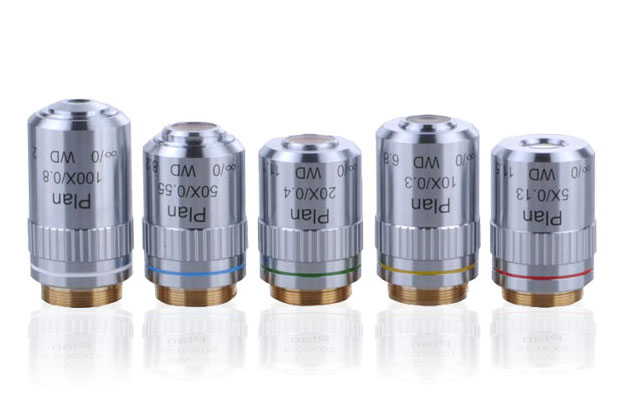
This lens is used to match the refractive index of the two wavelengths (colors) of light. This lens is widely available, partly because of its affordability.
Semi-Apochromatic Lenses
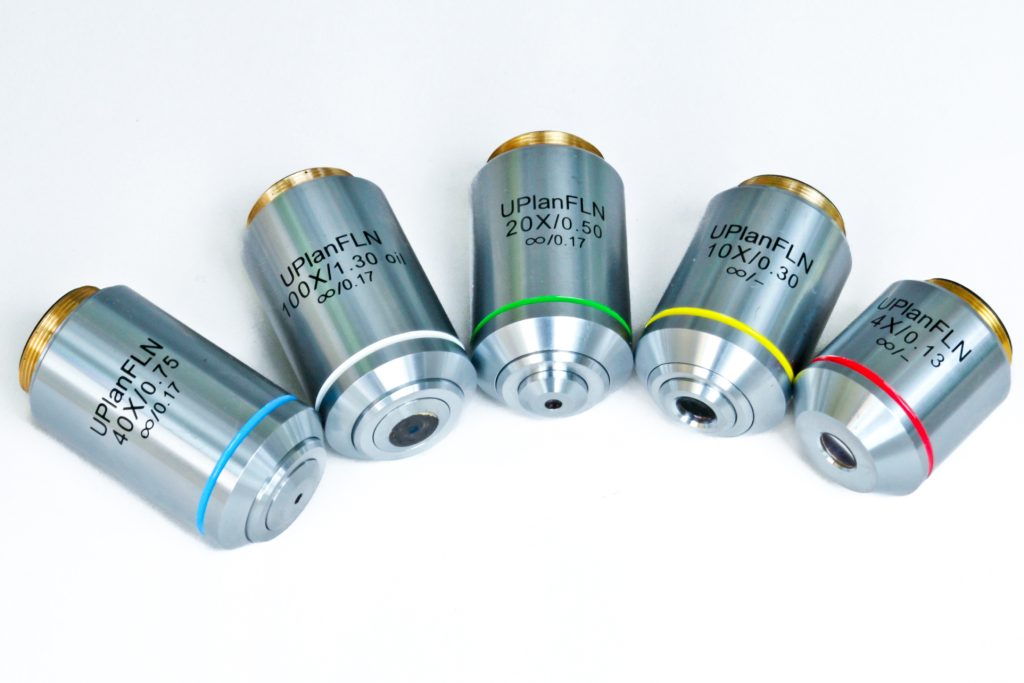
This lens is used to make the refractive index of the three wavelengths (colors) of light consistent. This lens has the transmittance necessary to observe ultraviolet light with a wavelength of about 340 nm, and is therefore suitable for fluorescence observation.
Apochromatic Lenses
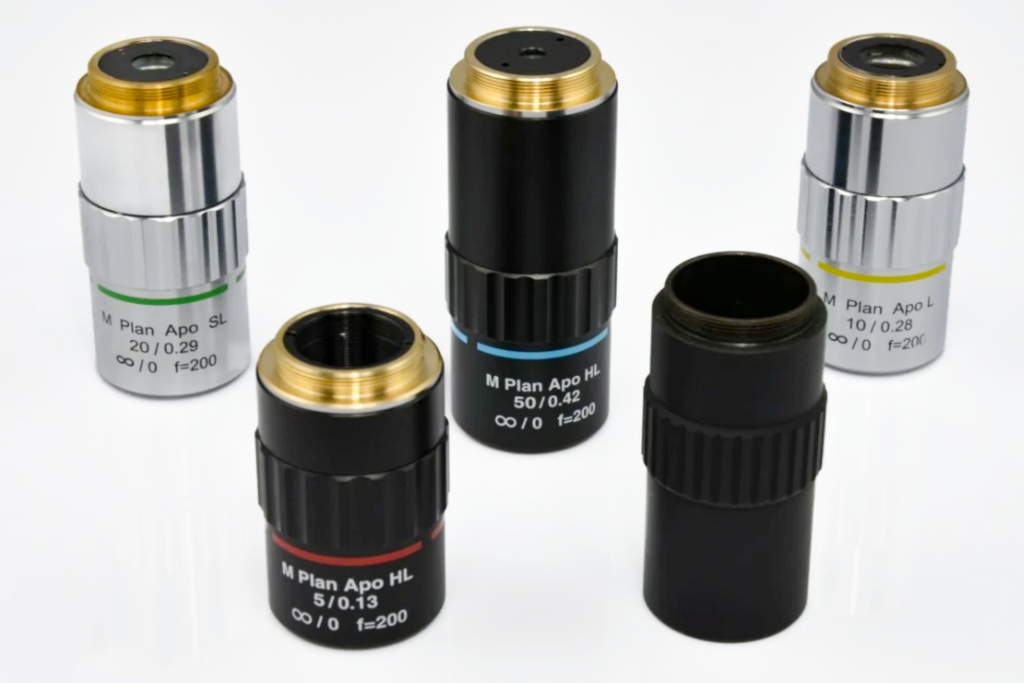
Like a semi-apochromatic lens, this lens is used to make the refractive index of the three wavelengths (colors) of light consistent. This lens has a larger numerical aperture and better resolution, so it is usually used in scientific research fields that require detailed observation. This lens has higher performance, so the price is higher.
Flat field lens
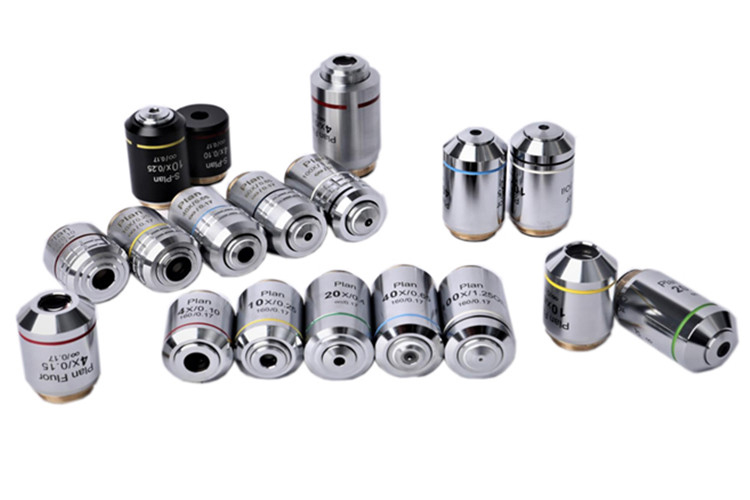
The field curvature aberration of this lens is corrected so that both the center and the periphery of the lens are in focus. If the field curvature aberrations of the above three lenses are corrected, they can be called plan achromat lenses, plan fluorite lenses and plan apochromat lenses respectively. In most cases, it is marked “PLAN” on the side of the lens.
Immersion lens

These lenses allow higher resolution to be achieved by increasing the numerical aperture by filling the space between the objective lens and the specimen with a liquid. Immersion lenses that work with oil are known as oil immersion lenses, while those that work with water are known as water immersion lenses. Oil immersion lenses are marked “HI” or “OIL” on the side, while water immersion lenses are marked “W” or “WATER” on the side.
Eyepiece
The eyepiece is the lens mounted on the observer’s side. After the image is magnified by the objective lens, it is further magnified by the eyepiece to facilitate observation. The eyepiece is composed of 1 to 3 lenses, and the field diaphragm can also be set to eliminate unnecessary reflected light and aberration.
Depending on the magnification (such as 7× and 15×), different types of eyepieces can be used. In addition to magnification, lens performance can also be expressed as the field number, which is the extent of the field of view. the
Contrary to objective lenses, eyepieces with higher magnification have shorter lengths. the
Depending on the construction or application of the field diaphragm, the following lenses can be mounted:
Huygens lens
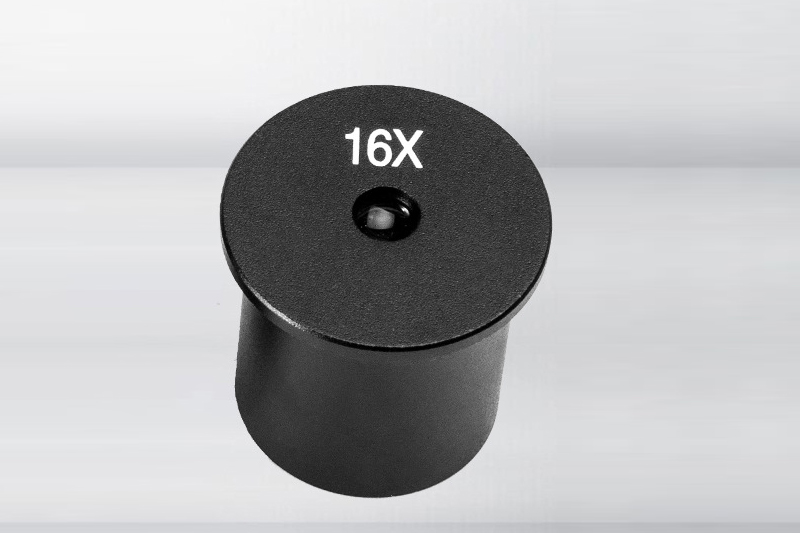
A Huygens lens consists of two plano-convex lenses. These lenses are intended for low magnification observation and feature a field diaphragm located in the lens barrel.
Ramsden lens
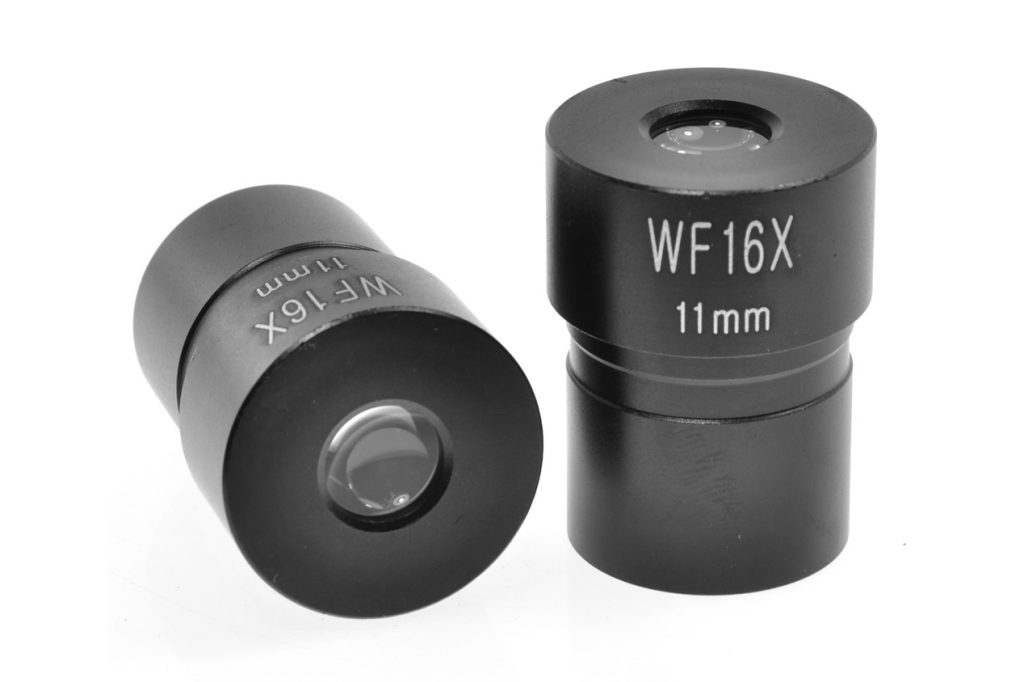
The special feature of this lens is that the field diaphragm is not in the lens barrel.
Periplan lens
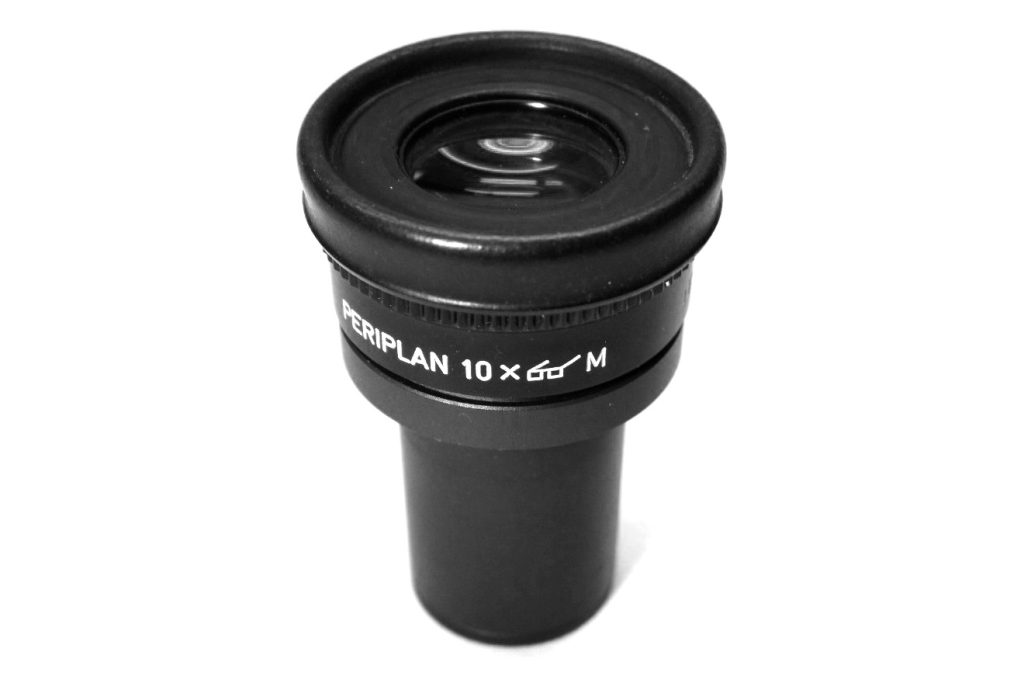
Even at the periphery of the field of view, this lens corrects for chromatic aberration in magnification and other characteristics, enabling clean observation.
Compensating eyepiece
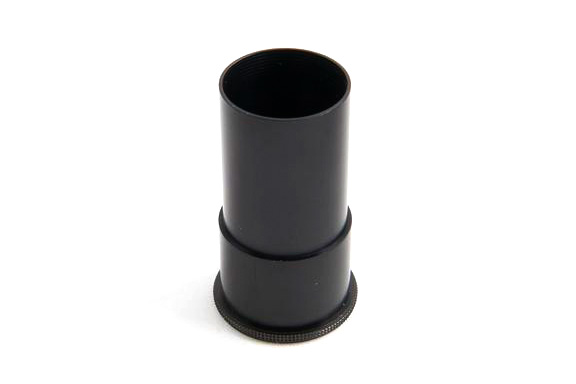
Eyepieces are designed for use with apochromatic objectives. Because the blue image generated by the apochromatic objective lens is larger than the red image, that is, there is residual lateral chromatic aberration, and the compensating eyepiece is designed so that the red image is larger than the blue image, so as to offset the lateral chromatic aberration of the apochromatic objective lens. The image field curvature of the compensating eyepiece is relatively serious. Due to the development of the new flat-image eyepiece, the compensating eyepiece is rarely used now.
Wide field lens

This lens achieves a wide field of view and is mainly used for observing living things and minerals.
Condenser
The condenser is a lens mounted under the stage. The condenser lens can adjust the amount of light so that the light illuminates the object evenly. This lens is suitable for high-magnification observation. Condensing lenses can be divided into various types, including ordinary “Abbe condensers” and “achromatic condensers” for correcting chromatic aberration.
Abbe Condenser
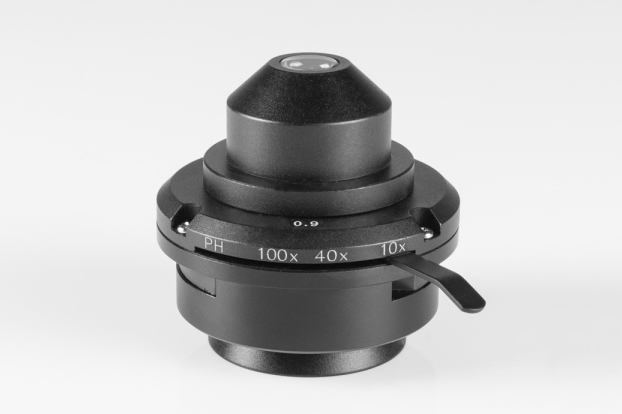
Designed by Ernst Abbe (one of the founders of the Zeiss company), a master of the German University of Optics. The Abbe condenser is composed of two lenses and has good light-gathering ability, but when the numerical aperture of the objective lens is higher than 0.60, chromatic aberration and spherical aberration will appear. Therefore, it is mostly used on ordinary microscopes.
Achromatic Condenser
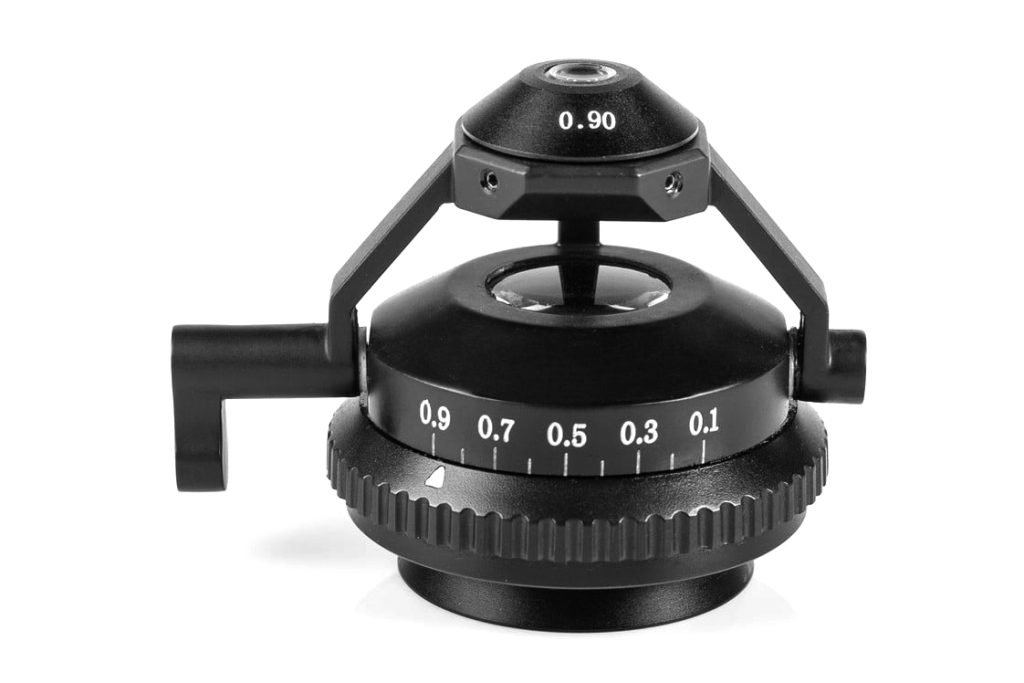
This kind of condenser is also known as “achromatic aplanatic condenser” and “qiming condenser”. It is composed of a series of lenses. It has a high degree of correction for chromatic aberration and spherical aberration, and can obtain an ideal image. It is a condenser with the highest quality in bright field microscopy, and its NA value is 1.4.
About magnification
The total observation magnification is expressed as the product of the objective magnification and the eyepiece magnification. For example, if the objective has a magnification of 20× and the eyepiece has a magnification of 10×, the total magnification is 200×.
1× refers to the state where the observer observes the object at a distance of 250 mm from the object. 250 mm is considered the easiest distance to be observed by the human eye. This distance is called the photopic distance.
The magnification of the eyepiece is equal to the distance of vision divided by the focal length of the lens.
How to Clean a Lens
After using the microscope, it is necessary to clean the dust, oil and dirt, because the lens is easy to stick to dust, fingerprints or culture fluid during use.
When cleaning the lens, the following tools are mainly required:
- air blow
- lens cleaning paper
- cotton swab
- Cleaning agent (manufacturer’s recommended cleaning agent, absolute alcohol, a mixture of ether and alcohol, distilled water, etc.)